Rapid Response and Expertise: The Role of 24-Hour Commercial Water Damage Restoration Contractors in Austin, Texas
/Emergency water damage restoration services
In the bustling city of Austin, Texas, commercial enterprises play a vital role in contributing to the vibrant economy. However, when unexpected water damage occurs, businesses face the challenge of minimizing downtime and restoring operations swiftly. In this exploration, we delve into the crucial role of 24-hour commercial water damage restoration contractors in Austin, emphasizing their rapid response capabilities, specialized expertise, and the comprehensive services they offer to businesses in times of crisis.
The Significance of 24-Hour Emergency Response:
Swift Mitigation of Damages: Water damage in commercial properties requires immediate attention to mitigate the extent of damages. Whether caused by flooding, burst pipes, or other unforeseen events, a prompt response is essential to prevent structural deterioration, mold growth, and damage to valuable assets. 24-hour commercial water damage restoration contractors in Austin recognize the urgency of such situations and are equipped to respond swiftly, minimizing the overall impact on businesses.
Minimization of Downtime: For commercial enterprises, downtime directly translates to financial losses. The longer a business remains non-operational due to water damage, the greater the impact on revenue, customer satisfaction, and employee productivity. 24-hour emergency response ensures that restoration efforts commence immediately, working towards minimizing downtime and expediting the return to normal business operations.
Preservation of Assets and Inventory: Commercial properties often house valuable assets, equipment, and inventory. Water damage poses a significant threat to these items, leading to potential financial losses. A rapid response from 24-hour commercial water damage restoration contractors is crucial in preserving assets and inventory, salvaging what can be saved, and implementing measures to prevent further damage.
Prevention of Secondary Damages: Water damage has the potential to cause secondary issues, such as mold growth and structural deterioration, if not addressed promptly. 24-hour emergency response is not only about immediate action but also about implementing measures to prevent secondary damages. Contractors employ specialized techniques to thoroughly dry and dehumidify affected areas, mitigating the risk of mold infestations and ensuring the long-term integrity of the property.
Specialized Expertise in Commercial Water Damage Restoration:
Understanding Commercial Infrastructure: Commercial properties often have complex infrastructure with unique challenges in comparison to residential spaces. 24-hour commercial water damage restoration contractors possess specialized expertise in understanding the intricacies of commercial structures, including large office spaces, retail establishments, and industrial facilities. This knowledge allows them to tailor their restoration efforts to the specific needs of commercial clients.
Advanced Equipment and Technology: The restoration of water-damaged commercial properties requires advanced equipment and technology. 24-hour emergency response teams are equipped with state-of-the-art tools for water extraction, drying, and dehumidification. This advanced equipment accelerates the restoration process and ensures thorough results, allowing businesses to resume operations as quickly as possible.
Experience with Large-Scale Restoration Projects: Commercial water damage incidents often involve larger spaces and more extensive damages than residential cases. 24-hour commercial water damage restoration contractors bring valuable experience in handling large-scale restoration projects. This includes coordinating efforts across expansive areas, managing multiple restoration teams, and efficiently addressing the unique challenges posed by commercial settings.
Comprehensive Services Offered by 24-Hour Commercial Water Damage Restoration Contractors:
Emergency Water Extraction: Immediate water extraction is the first step in mitigating commercial water damage. 24-hour emergency response teams deploy powerful pumps and extractors to remove standing water swiftly. This process is essential for preventing further damage and creating a foundation for subsequent restoration efforts.
Drying and Dehumidification: Thorough drying and dehumidification are critical to prevent secondary damages such as mold growth. 24-hour commercial water damage restoration contractors use industrial-grade dehumidifiers, air movers, and drying equipment to eliminate residual moisture from walls, flooring, and other affected surfaces.
Structural Drying and Repairs: Commercial properties may have unique structural elements that require specialized drying techniques. 24-hour emergency response teams focus on structural drying, addressing water infiltration in walls, ceilings, and other structural components. Concurrently, they initiate repairs to restore the integrity of the building's structure.
Content Restoration and Salvage: Businesses often store valuable equipment, documents, and inventory on their premises. 24-hour commercial water damage restoration contractors prioritize content restoration and salvage efforts. This includes cleaning, drying, and restoring items affected by water damage to the extent possible.
Mold Remediation: Mold growth is a common concern after water damage incidents. 24-hour emergency response teams are well-versed in mold remediation protocols. They conduct thorough inspections, identify mold-infested areas, and implement effective remediation strategies to ensure a healthy and safe environment for occupants.
Documentation for Insurance Claims: Commercial property owners must navigate the insurance claims process efficiently. 24-hour commercial water damage restoration contractors play a vital role in this aspect by providing detailed documentation of the damages, restoration efforts, and associated costs. This documentation is crucial for expediting insurance claims and facilitating a smooth resolution.
Coordination with Stakeholders: Commercial water damage restoration involves coordination with various stakeholders, including property owners, facility managers, and insurance adjusters. 24-hour emergency response teams excel in effective communication and collaboration, ensuring that all parties are informed, and restoration efforts proceed seamlessly.
Preventive Measures and Recommendations: In addition to addressing immediate damages, 24-hour commercial water damage restoration contractors provide valuable insights into preventive measures. This may include recommendations for improving drainage systems, addressing structural vulnerabilities, and implementing measures to minimize the risk of future water damage incidents.
Conclusion:
In the dynamic business landscape of Austin, Texas, the role of 24-hour commercial water damage restoration contractors cannot be overstated. Their ability to respond swiftly to water damage emergencies, coupled with specialized expertise in addressing the unique challenges of commercial properties, makes them invaluable partners for businesses facing unexpected crises. Through advanced equipment, comprehensive services, and a commitment to minimizing downtime, these emergency response teams contribute to the resilience and continuity of commercial enterprises in the face of water-related challenges. As businesses in Austin navigate the complexities of property restoration, 24-hour commercial water damage restoration contractors stand as trusted allies, working tirelessly to restore properties and revitalize the economic heartbeat of the city.






















